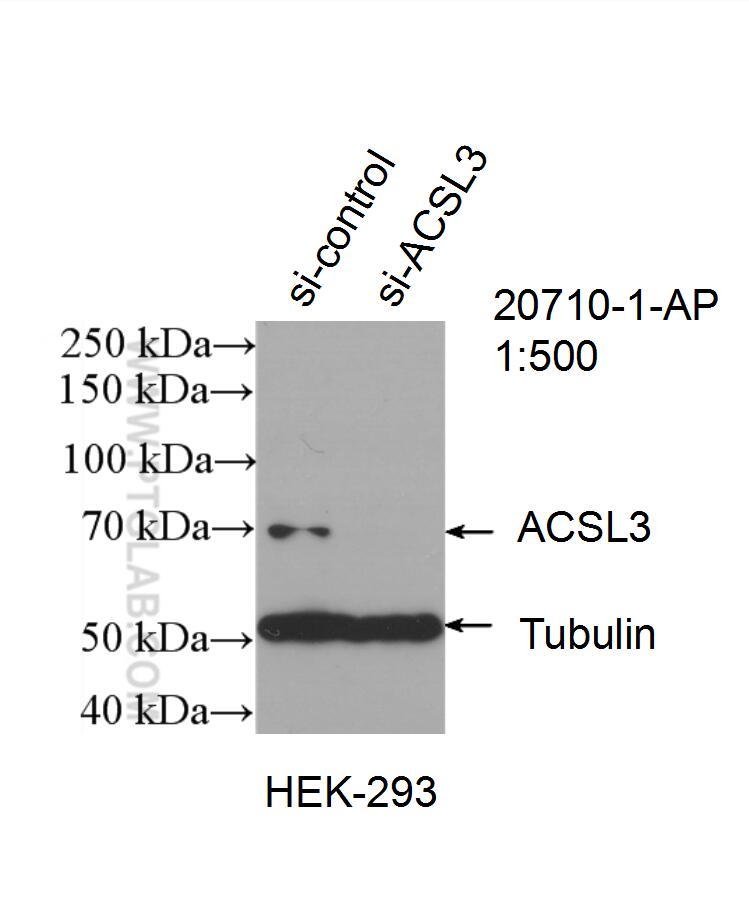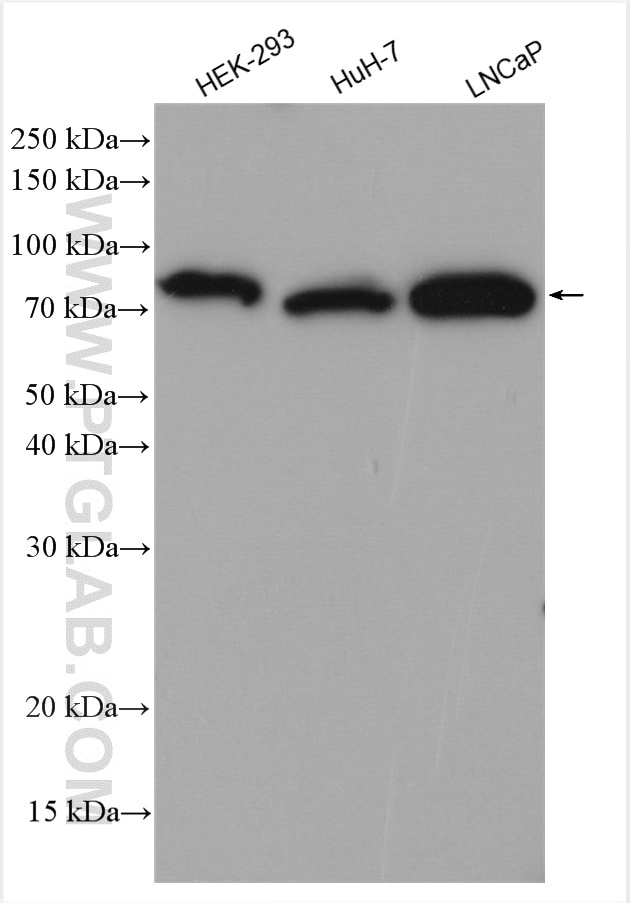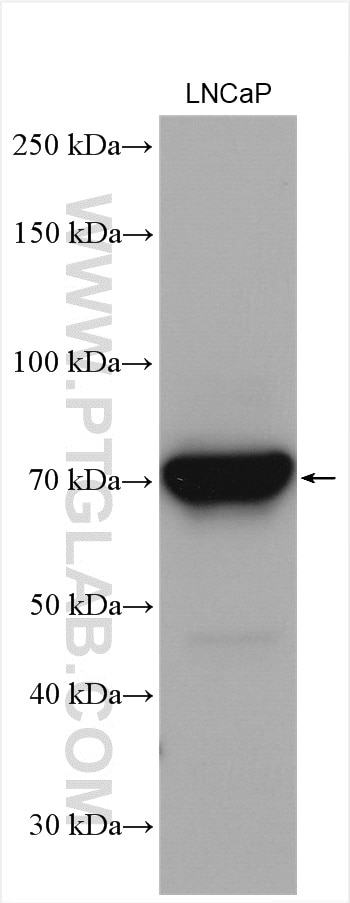- Phare
- Validé par KD/KO
Anticorps Polyclonal de lapin anti-ACSL3
ACSL3 Polyclonal Antibody for WB, IHC, ELISA
Hôte / Isotype
Lapin / IgG
Réactivité testée
Humain, souris
Applications
WB, IHC, IF, ELISA
Conjugaison
Non conjugué
N° de cat : 20710-1-AP
Synonymes
Galerie de données de validation
Applications testées
| Résultats positifs en WB | cellules HEK-293, cellules HuH-7, cellules LNCaP |
| Résultats positifs en IHC | tissu de cancer de l'estomac humain, il est suggéré de démasquer l'antigène avec un tampon de TE buffer pH 9.0; (*) À défaut, 'le démasquage de l'antigène peut être 'effectué avec un tampon citrate pH 6,0. |
Dilution recommandée
| Application | Dilution |
|---|---|
| Western Blot (WB) | WB : 1:2000-1:12000 |
| Immunohistochimie (IHC) | IHC : 1:50-1:500 |
| It is recommended that this reagent should be titrated in each testing system to obtain optimal results. | |
| Sample-dependent, check data in validation data gallery | |
Applications publiées
| WB | See 20 publications below |
| IHC | See 4 publications below |
| IF | See 1 publications below |
Informations sur le produit
20710-1-AP cible ACSL3 dans les applications de WB, IHC, IF, ELISA et montre une réactivité avec des échantillons Humain, souris
| Réactivité | Humain, souris |
| Réactivité citée | Humain, souris |
| Hôte / Isotype | Lapin / IgG |
| Clonalité | Polyclonal |
| Type | Anticorps |
| Immunogène | Peptide |
| Nom complet | acyl-CoA synthetase long-chain family member 3 |
| Masse moléculaire calculée | 80 kDa |
| Poids moléculaire observé | 70-80 kDa |
| Numéro d’acquisition GenBank | NM_004457 |
| Symbole du gène | ACSL3 |
| Identification du gène (NCBI) | 2181 |
| Conjugaison | Non conjugué |
| Forme | Liquide |
| Méthode de purification | Purification par affinité contre l'antigène |
| Tampon de stockage | PBS with 0.02% sodium azide and 50% glycerol |
| Conditions de stockage | Stocker à -20°C. Stable pendant un an après l'expédition. L'aliquotage n'est pas nécessaire pour le stockage à -20oC Les 20ul contiennent 0,1% de BSA. |
Informations générales
ACSL3, also named as ACS3, FACL3 and LACS3, belongs to the ATP-dependent AMP-binding enzyme family. Acyl-CoA synthetases (ACSL) activate long-chain fatty acids for both synthesis of cellular lipids, and degradation via beta-oxidation. ACSL3 mediates hepatic lipogenesis. Preferentially uses myristate, laurate, arachidonate and eicosapentaenoate as substrates. Has mainly an anabolic role in energy metabolism. Required for the incorporation of fatty acids into phosphatidylcholine, the major phospholipid located on the surface of VLDL (very low density lipoproteins). The antibody is specific to ACSL3.
Protocole
| Product Specific Protocols | |
|---|---|
| WB protocol for ACSL3 antibody 20710-1-AP | Download protocol |
| IHC protocol for ACSL3 antibody 20710-1-AP | Download protocol |
| Standard Protocols | |
|---|---|
| Click here to view our Standard Protocols |
Publications
| Species | Application | Title |
|---|---|---|
Cancer Commun (Lond) Blockage of EGFR/AKT and mevalonate pathways synergize the antitumor effect of temozolomide by reprogramming energy metabolism in glioblastoma | ||
Free Radic Biol Med Role of ferroptosis mediated by abnormal membrane structure in DEHP-induced reproductive injury | ||
Clin Transl Med NAT10: An RNA cytidine transferase regulates fatty acid metabolism in cancer cells | ||
Anal Chem Ionic Liquid-Based Extraction System for In-Depth Analysis of Membrane Protein Complexes. | ||
Biochim Biophys Acta Mol Cell Biol Lipids Rab18 binds PLIN2 and ACSL3 to mediate lipid droplet dynamics. |





